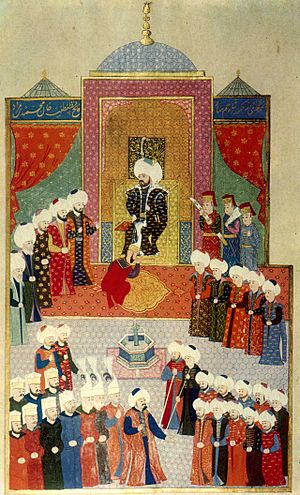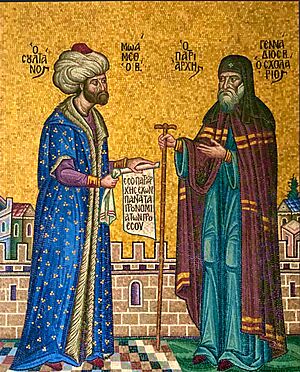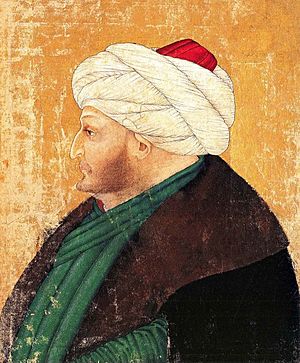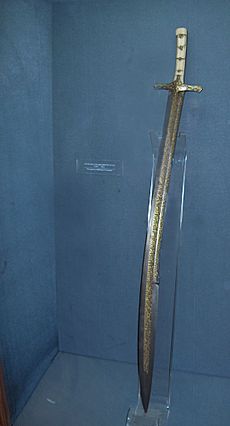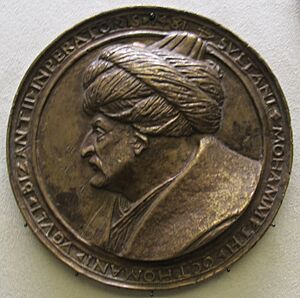Mehmed the Conqueror facts for kids
Quick facts for kids Mehmed the Conqueror |
|||||
|---|---|---|---|---|---|
| Sultan of the Ottoman Empire Kayser-i Rûm The Lord of the Two Lands and the Two Seas Padishah |
|||||
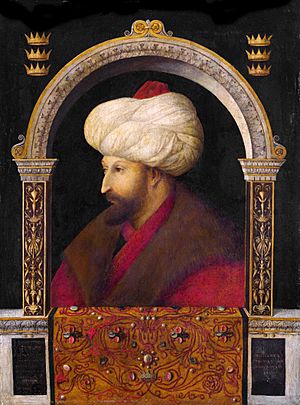
Portrait of Sultan Mehmet II, 1480, by Gentile Bellini (1429–1507), oil on canvas and perhaps transferred from wood, 69.9 x 52.1 cm. Now at the National Portrait Gallery in the UK.
|
|||||
| 7th Ottoman Sultan (Emperor) | |||||
| 1st reign | August 1444 – September 1446 | ||||
| Predecessor | Murad II | ||||
| Successor | Murad II | ||||
| 2nd reign | 3 February 1451 – 3 May 1481 | ||||
| Predecessor | Murad II | ||||
| Successor | Bayezid II | ||||
| Born | 30 March 1432 Edirne, Ottoman Sultanate |
||||
| Died | 3 May 1481 (aged 49) Hünkârçayırı (Tekfurçayırı), near Gebze, Ottoman Empire |
||||
| Burial | Fatih Mosque, Istanbul | ||||
| Consorts |
|
||||
| Issue |
|
||||
|
|||||
| Dynasty | Ottoman | ||||
| Father | Murad II | ||||
| Mother | Hüma Hatun | ||||
| Religion | Sunni Islam | ||||
| Tughra |  |
||||
Mehmed II, also known as Sultan Mehmed the Conqueror (born March 30, 1432 – died May 3, 1481), was a powerful Sultan of the Ottoman Empire. He ruled twice: first from 1444 to 1446, and then from 1451 to 1481. When he was just 21 years old, he achieved a major victory by conquering Constantinople. This event ended the Byzantine Empire and made Constantinople the new capital of the Ottoman Empire.
Mehmed continued to expand his empire. He conquered lands in Anatolia (modern-day Turkey) and in Europe, reaching as far as Bosnia and Croatia. Today, Mehmed II is seen as a national hero in Turkey. The famous Fatih Sultan Mehmet Bridge in Istanbul is named after him.
Contents
Early Life and First Reign
Mehmed II was born on March 30, 1432, in Edirne. At that time, Edirne was the capital city of the Ottoman Empire. His father was Sultan Murad II, and his mother was Valide Sultan Hüma Hatun.
When Mehmed was eleven, he was sent to Amasya to learn how to govern. This was a common practice for Ottoman princes to gain experience. In August 1444, after his father Murad II made peace with the Karaman Emirate, Murad II gave the throne to his 12-year-old son, Mehmed II.
Mehmed received a strong Islamic education from his teachers. This education shaped his beliefs and encouraged him to follow Sharia law. He was especially influenced by his mentor, Molla Gürani, and by Ak Şemseddin. Ak Şemseddin taught him the importance of conquering Constantinople to fulfill an Islamic duty.
During his first rule, Mehmed II faced a crusade led by János Hunyadi. The Hungarian forces had broken a peace agreement called the Peace of Szeged. A representative of the pope, Cardinal Julian Cesarini, had told the Hungarian king that breaking the truce with Muslims was acceptable.
Mehmed II asked his father, Murad II, to return and lead the army. When Murad II refused, Mehmed wrote a strong letter. He told his father that if he was the Sultan, he should lead the armies. If Mehmed himself was the Sultan, he was ordering his father to lead. After receiving this letter, Murad II led the Ottoman army and won the Battle of Varna in 1444.
Some say that Murad II was forced to return to the throne by Çandarlı (2nd) Halil Pasha. He was the grand vizier (a high-ranking minister) and did not like Mehmed II's rule. Çandarlı was later removed from his position by Mehmed II during the siege of Constantinople.
Conquering Constantinople
When Mehmed II became Sultan again in 1451, he focused on making the Ottoman Navy stronger. He also started preparing to capture Constantinople. His great-grandfather, Bayezid I, had built a fortress called Anadoluhisarı on the Asian side of the narrow Bosporus Straits. Mehmed built an even stronger fortress, Rumelihisarı, on the European side. This gave him full control of the strait.
Once his fortresses were ready, Mehmed started charging a toll for ships passing through. A Venetian ship that refused to stop was sunk, and its surviving sailors were executed.
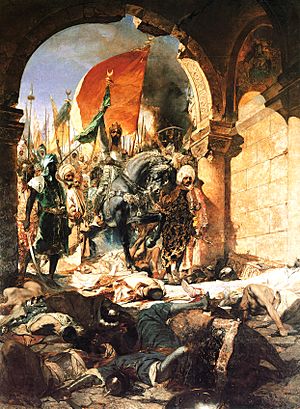
In 1453, Mehmed began the siege of Constantinople. His army had between 80,000 and 200,000 soldiers. His navy had 320 ships, mostly for transport. The city was surrounded by land and sea. The Ottoman fleet blocked the entrance to the Bosphorus to stop any help from reaching the city.
The siege began in early April. The city's strong walls held off the Ottoman attacks, even against new powerful cannons. The harbor of the Golden Horn was blocked by a chain and defended by warships.
On April 22, Mehmed did something clever. He moved his lighter warships overland, around the Genoese colony of Galata, and into the Golden Horn. Eighty ships were moved over a mile of wooden paths. This forced the Byzantines to spread their defenders along more of the walls. Just over a month later, on May 29, Constantinople fell after a 57-day siege.
After this victory, Mehmed moved the Ottoman capital from Adrianople to Constantinople. By the age of 21, Mehmed was known to speak several languages. These included Turkish, Arabic, Hebrew, Persian, Greek, and Latin.
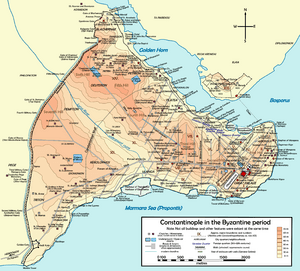
There is a famous saying attributed to the Prophet Muhammad about Constantinople: "You shall conquer Constantinople. What a wonderful leader will he be, and what a wonderful army will that army be!" Ten years after conquering Constantinople, Mehmed II visited the ancient city of Troy. He proudly said that he had avenged the Trojans by conquering the Greeks (Byzantines).
When Mehmed walked into the ruins of the Boukoleon Palace, he spoke famous lines of Persian poetry:
- The spider weaves the curtains in the palace of the Caesars;
- the owl calls the watches in the towers of Afrasiab.
After Constantinople fell, Mehmed claimed the title of "Caesar" of Rome (Kayser-i Rûm). This claim was not accepted by the Christian leaders in Europe. Mehmed's claim was based on the idea that Constantinople was the true capital of the Roman Empire. He also had some family connection to the Byzantine Imperial family.
Conquests in Asia
With Constantinople conquered, Mehmed II could focus on Anatolia. He wanted to unite all the Turkish states, called Beyliks, and the Greek Empire of Trebizond under Ottoman rule. He also allied with the Crimean Khanate north of the Black Sea.
Sultan Bayezid I had tried to unite Anatolia before, but his efforts were undone after the Battle of Ankara in 1402. Mehmed II successfully brought these Turkish states back under Ottoman control. These conquests helped him expand further into Europe.
Another important group was the White Sheep Turcomans, led by Uzun Hasan. This kingdom grew powerful in the East. They had strong ties with Christian powers like the Empire of Trebizond and the Republic of Venice. Mehmed saw them as a threat. In 1473, he led a successful campaign against Uzun Hasan, winning a major victory at the Battle of Otlukbeli.
Conquests in Europe
After taking Constantinople, Mehmed continued his conquests in Europe. He conquered the Despotate of Morea in 1460 and the Empire of Trebizond in 1461. These were the last parts of the Byzantine Empire. The conquest of Constantinople brought great fame to the Ottoman Empire.
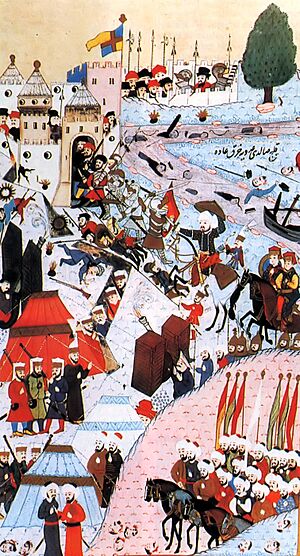
Mehmed II moved into Eastern Europe, reaching Belgrade. He tried to conquer Belgrade from John Hunyadi in 1456. Hungarian commanders successfully defended the city, and the Ottomans suffered heavy losses. However, the Ottomans eventually took control of almost all of Serbia.
In 1463, Mehmed invaded Bosnia after a disagreement about annual payments. He quickly conquered it and removed the last Bosnian king.
In 1462, Mehmed II had a conflict with Prince Vlad III Dracula of Wallachia. Vlad had spent some of his childhood with Mehmed. Vlad attacked and captured many Ottoman forces. He then announced that he had impaled over 23,000 captured Turks. Mehmed II launched an attack against Vlad in Wallachia. However, Mehmed's army suffered many losses in a surprise night attack led by Vlad. Mehmed II withdrew, leaving Vlad's brother, Radu cel Frumos, to take control of Wallachia.
In 1475, the Ottomans faced a big defeat against Stephen the Great of Moldavia at the Battle of Vaslui. In 1476, Mehmed won a difficult victory against Stephen at the Battle of Valea Albă. He tried to capture the capital of Suceava but could not. With sickness in his camp and little food, Mehmed had to retreat.
The Albanian resistance, led by Skanderbeg, stopped the Ottoman expansion into the Italian peninsula. Skanderbeg united the Albanian Principalities in 1444 to fight the Empire. Mehmed II could not defeat Albania or Skanderbeg while Skanderbeg was alive. He led his armies against Krujë twice (1466 and 1467). After Skanderbeg's death in 1468, the Albanians could not find a new leader. Mehmed II eventually conquered Krujë and Albania in 1478. The last major siege he led was the siege of Shkodra in 1478-79.
Mehmed II invaded Italy in 1480. His goal was to capture Rome and "reunite the Roman Empire." At first, it seemed possible with the easy capture of Otranto in 1480. But Otranto was retaken by Papal forces in 1481 after Mehmed's death.
Administrative Changes

Mehmed II combined the old Byzantine government with the Ottoman state. He brought Italian artists, scholars, and Greek thinkers to his court. He allowed the Byzantine Church to continue its work. He ordered the patriarch to translate Christian teachings into Turkish. He also invited Gentile Bellini from Venice to paint his portrait. Mehmed invited Muslim scientists and artists to his court in Constantinople. He started a university, built mosques like the Fatih Mosque, and created waterways. He also built Istanbul's Topkapı Palace.
Mehmed II gave his subjects a lot of religious freedom, as long as they obeyed his rule. After conquering Bosnia and Herzegovina in 1463, he issued a special order called a firman. This order allowed the Bosnian Franciscans to move freely, worship in their churches, and practice their religion without harm. His army included soldiers from the Devshirme system. This system took young Christian boys to serve the Sultan. The strongest were trained for the army or the Sultan's personal guard, the Janissaries.
In Constantinople, Mehmed created a millet, which was an independent religious community. He appointed the former Patriarch as the religious leader of the city. This system allowed for indirect rule of the Christian Byzantines. It also made the people feel somewhat independent as Mehmed II began to transform the city into the Turkish capital.
Personal Life
Mehmed II had several wives. These included Validā Khātûn Âminā Kul-Bahar Khātûn, who was an Albanian Christian. Other wives were Gevher Khātûn, Gül-Şâh Khātûn, Mûkrîmā Khātûn, Çiçek Khātûn, Helenā Khātûn, and briefly Anna Khātûn. He also had a son named Cem Sultan.
Death
Mehmed II passed away on May 3, 1481, at the age of 49. He was buried in his Türbe (tomb) at the Fatih Mosque Complex in Istanbul. There were some suspicions about his death, with some sources suggesting he might have been poisoned.
Legacy
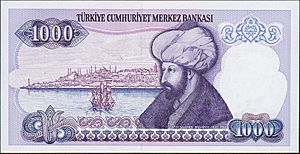
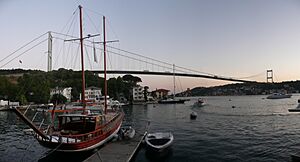
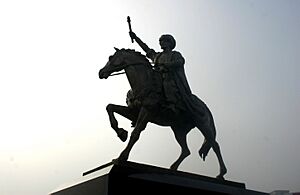
After conquering Constantinople, Mehmed II established many universities and colleges in the city. Some of these are still active today. He was also the first Sultan to create official laws for criminal and constitutional matters. This happened long before Suleiman the Magnificent. He helped shape the image of the Ottoman Sultan as a strong ruler.
During his 31-year rule, Mehmed's many wars expanded the Ottoman Empire. It grew to include Constantinople, Turkish kingdoms in Asia Minor, Bosnia, the Kingdom of Serbia, and Albania. His internal changes to the government and laws helped his country become successful. These changes also prepared the way for future sultans to expand the empire even more.
Mehmed left a lasting impression in both the Islamic and Christian worlds. The Fatih Sultan Mehmet Bridge in Istanbul, built in the 20th century, is named after him. His name and picture were also on the Turkish 1000 lira banknote from 1986 to 1992.
Portrayals in Media
- Sultan Mehmed II Fetih was played by Sami Ayanoğlu in the Turkish film İstanbul'un Fethi (1951).
- Devrim Evin plays Mehmed II in the Turkish film Fetih 1453 (2012). His childhood is portrayed by Ege Uslu.
Images for kids
-
Roumeli Hissar Castle, built by Sultan Mehmed II before the Fall of Constantinople.
-
Sultan Mehmed II entering Constantinople, painted by Fausto Zonaro.
-
An Ottoman miniature painting of the Siege of Belgrade in 1456.
-
Portrait of Vlad (Dracula) the Impaler, Prince of Wallachia.
-
The Night Attack of Târgovişte, which was a victory for Vlad (Dracula) the Impaler.
-
Mehmed the Second, a portrait by Paolo Veronese.
-
Portrait of Skanderbeg, prince of League of Lezhë.
-
The tomb of Mehmed II in Fatih, Istanbul.
See also
 In Spanish: Mehmed II para niños
In Spanish: Mehmed II para niños



